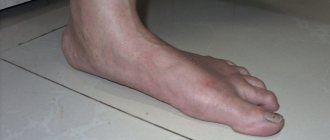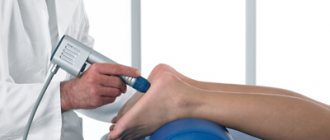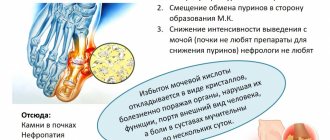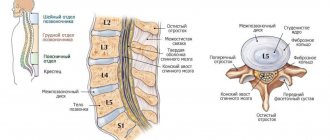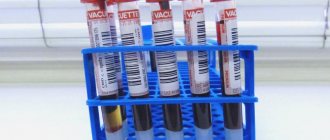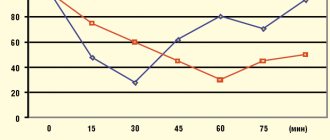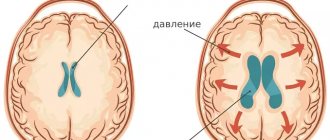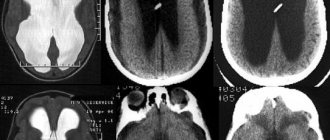Experts:
Razmik Keshishyan , Doctor of Medical Sciences, Professor, pediatric surgeon of the highest qualification category,
Deputy Chief Physician for Medical Work of the Research Institute of Emergency Pediatric Surgery and Traumatology,
Chief pediatric traumatologist-orthopedist of the Moscow Department of Health
Konstantin Zherdev , Candidate of Medical Sciences, Head of the Department of Neuroorthopedics
and orthopedics of the Federal State Budgetary Institution "Scientific Center for Children's Health" of the Russian Academy of Medical Sciences
Nature has given the foot a shape that allows it to evenly distribute body weight. Normally, the foot rests on three points; it is supported by the longitudinal and transverse arches, which also act as a natural shock absorber, softening the shocks and shocks of the body when walking or running, making the gait smooth and light. And if the arches are flattened and smoothed, and the feet themselves are “spread out” in the middle part, then this is flat feet.
If the foot is changed, the first to suffer are the muscles of the foot, which weaken under the weight of the body. The ligaments behind them fail. And then the foot settles, becomes flat, and loses its main function - springing. Every step can cause pain in the calf muscles, ankle and knee joints, lower back and spine.
Rarely, flat feet can be congenital. This is detected immediately in the maternity hospital, since the pathology is very noticeable: a convex foot and its anterior section “turned” outward. Treatment is carried out from the first days of the child’s life: the deformity is gradually corrected using plaster casts. If this does not help, they resort to surgery.
As a rule, changes in the foot are an acquired disease. According to statistics, more than 65% of children have flat feet by school age. Even more patients are leaving the educational institution.
Big problems for a little leg
It is only at first glance that it seems that a child’s leg is a smaller copy of an adult’s. In babies, the longitudinal arch of the foot is flat. This is due to the fact that the bone tissue is still soft, the muscular system is not developed enough. When children begin to walk independently, the function of a shock absorber is taken over by the “fat pad”, which is located on the foot. By the age of two or three, the ligaments and muscles become stronger, which allows the child to be “on his feet” longer. This is when flat feet can be diagnosed. By the way, in children under 9 years of age, longitudinal deformation is more common, since the transverse arch is just forming at this age.
There is an opinion that children under 3 years old do not have flat feet. This is not entirely true. There are children who are at risk. These are kids:
- whose parents have flat feet. The hereditary factor plays a significant role in this disease;
- early (before 8–9 months) those who began to get up and walk;
- with dysplastic syndrome (joint hypermobility);
- with endocrine diseases;
- with excess body weight;
- with post-strachitic deformity of the lower extremities;
- with an incorrectly healed fracture of the leg and foot bones.
Therapeutic and preventive insoles
Purpose and features of preventive insoles
Ready-made orthopedic insoles, which can be purchased at a pharmacy or store, support the arch of the foot. The arches may not withstand heavy physical exertion, pregnancy, sudden weight gain, in old age, or in people who are weakened due to another disease. To prevent flat feet from developing in these cases, preventive supportive insoles are needed.
Properties and purpose of therapeutic insoles
Such products are intended for those who have already been diagnosed with certain foot problems. After an accurate medical diagnosis, such products are manufactured individually. The foot contains 20 joints and 28 bones. When walking, this part of the leg performs a pushing function and maintains balance. Due to trauma, abnormal development, and other problems, the coordination of the various parts of this complex system is disrupted. As a result, pain appears, adaptive reactions occur, and a painful reaction of the body as a whole may occur. The task of the insole in this case is not only to support the arches, but also to compensate for pathology and prevent serious general disorders.
SOS signal
The first symptoms of flat feet are that the gait loses its smoothness, the soles of the shoes may slip to one side, and the shoes that recently fit become small due to the expansion of the foot. Children quickly get tired while walking, ask to be held, and complain of pain in the legs or lower back. There are also problems with ingrown toenails.
The onset of the disease can be determined visually by simply looking at the child’s heel to see if it is tilting to one side or the other. In medical language, this is called an X- or O-shaped deformity of the ankle joints. This happens because the weight of the baby’s body when walking is distributed unevenly, and the foot is positioned incorrectly.
Flat foot test
You can determine if you or your child has flat feet using a fairly simple test. Take a sheet of paper and stand on it with your bare feet, after lubricating them with something greasy, such as oil. Make sure that your body weight is distributed evenly. If you have absolutely no problems with your feet, then you will see the following picture:
If you receive a print similar to the one shown below, consult a doctor as soon as possible. He will help you understand your problem and make the correct diagnosis.
Please note that in the absence of flat feet, the big toe should form one straight line with the heel. Patients who have flat feet often experience ingrown nails. Also, the presence of flat feet can be indicated by an irregularly shaped foot, as well as slightly curved toes. One of the consequences of flat feet is a protruding bone on the big toe. Flat feet lead to the appearance of various unpleasant symptoms such as “heel spurs” or calluses. This fact is worth taking note of for people with problem feet - perhaps the reason for your numerous calluses lies not in your shoes, but in the irregular shape of your foot. There is only one way to find out - by visiting an orthopedist. Remember that it is never too late to see an orthopedist, even if you are quite old.
We recommend that you familiarize yourself with the following signs of problem feet:
- wear and tear of your shoes on the inside;
- the wide dimensions of your feet do not allow you to fit into your favorite shoes;
- constant feeling of fatigue in the legs when walking;
- an unexpected feeling of discomfort when wearing high-heeled shoes;
- the appearance of swelling, pain or cramps in the legs.
If any of these signs are found in you or, more importantly, in your child, then seek help from a doctor immediately. Remember that flat feet are much easier to eliminate in childhood, when the skeleton has not yet completely ossified.
All according to plan
An orthopedic examination is required:
– immediately after birth, this is necessary to exclude congenital deformities and skeletal diseases, including congenital flat feet; also at this age it is necessary to conduct an ultrasound examination of the hip joints;
– at 3 and 6 months;
– at 1 year, when the child already sits, crawls, and walks independently;
– at 3 years of age to check posture, gait, condition of the feet and measure the length of the limbs.
What are the dangers of foot deformities?
Foot deformities cannot be ignored. Without treatment and correction, over time they will lead to disorders in the ankle, knee, hip joints, incorrect position of the pelvis, and overload of individual muscles. They can cause premature wear of overlying joints in adulthood, the development of osteochondrosis, arthrosis, curvature of the spine, and poor posture.
Foot deformities affect the general condition of the child, cause pain, fatigue, make walking difficult, and contribute to improper development of the musculoskeletal system. They lead to other foot problems: ingrown toenails, crooked toes, calluses, corns.
Don't miss the moment
Fortunately, inherited and acquired foot defects can be corrected. With the help of special rehabilitation measures, it is possible to stop the disease and prevent it from developing into a more severe form. Depending on the child’s age, his development, and the nature of the flattening of the foot, the doctor will prescribe a massage and a special set of exercises that need to be performed at home. If your child does gymnastics diligently, positive results will soon make themselves felt: the arch of the foot will become significantly stronger, take on an arched shape, and the displaced heel will take its usual place.
Daily warm (35–36°C) foot baths, leg and foot massage (rubbing, stroking and kneading) will be good allies. These procedures improve blood circulation and tone the muscles that lift the arch of the foot. Massage the inner surface of the shin in the direction from the ankle to the knee, and the feet from the toes to the heel.
In addition, the specialist will help you choose orthopedic shoes or recommend making individual corrective devices (orthopedic insoles) with arch alignment and raising the inner or outer edge of the heel. The insoles create comfortable conditions for deformed feet; they can be worn from the age of two after consultation with an orthopedic doctor. Do not forget to periodically see a doctor for timely correction of the height of the instep supports. Insoles should be included in both outdoor and indoor shoes.
You should not choose orthopedic shoes on your own: even a small mistake can aggravate the problem.
It is important to remember that all methods of conservative treatment end by the age of 10, when the processes of formation of the physiological arches of the foot are completed and only surgical intervention is possible.
Stores sell many different devices (special mats, cushions, balls) for doing gymnastics and self-massage at home. Exercises help improve blood circulation and normalize muscle tone.
Medical examination
Flat feet in adults and children can be determined based on the clinical symptoms of the disease. To assess the extent of the pathological process, a serious examination of the patient is required. It includes several points. This:
- Plantography allows you to determine the severity of the pathological process using prints. To do this, a solution of methylene blue is applied to the feet. Then make prints on a blank sheet of paper. Plantography provides approximate data on the condition of the arches of the feet.
- The Friedland podometry method allows you to estimate the percentage of foot height to its length.
- The clinical method is based on the construction of a special triangle. Its base is equal to the distance from the head of the metatarsal bone to the tubercle of the heel. The vertex of the triangle is located in the center. The first leg reaches the highest point of the heel tubercle, the second - to the head of the metatarsus. Normally, the height of the arch should not exceed 60 cm.
- The X-ray method is also based on constructing a triangle, but in this case the angle at the apex is measured. This parameter should not exceed 130 degrees.
Based on the examination results, the orthopedic surgeon can confirm the diagnosis and make recommendations for treatment.
Do people with flat feet join the army? This question worries many young men who have reached adulthood. If a conscript is diagnosed with a 1st or 2nd degree foot deformity, he is required to serve in the armed forces. In case of longitudinal or transverse flatfoot of the 3rd degree, the young man is exempt from the army. He is given a military ID from Fr.
Useful tips
Simple preventive measures will help prevent the development of flat feet:
– the right choice of shoes, which should be made taking into account the growing child’s foot. Don’t press or rub anywhere, but don’t be too loose;
– each child has his own shoes: due to shoes worn out by a brother or sister, the load on the feet may be incorrectly distributed;
– the presence in the diet of foods rich in phosphorus and calcium, which prevent the development of rickets;
– in summer – sunbathing, in winter – preventive intake of vitamin D as prescribed by the pediatrician;
– moderate physical activity. Avoid activities with axial load - gymnastics, dancing and weight lifting;
– walking barefoot on pebbles, sand, earth, grass, which causes the feet to constantly strain. But you only need to walk on a flat and smooth floor in orthopedic shoes.
Prevention of flat feet in children
However, instead of wasting money, time, and most importantly nerves on getting rid of flat feet, a much better solution would be to eliminate the possibility of this disease in advance. Continuous implementation of preventive measures will help you with this. First, you need to make it a rule to undergo an annual examination by an orthopedist. The easiest way to prevent it is to undergo regular examination by an orthopedist. Another important step to preventing flat feet is choosing comfortable children's orthopedic shoes. Particular attention should be paid to the soles of shoes. It should be quite soft and flexible, and also be made of natural material. The child should feel as comfortable as possible in the shoes: the toes should be positioned freely, and the heel should be securely fixed with a hard heel. Avoid wearing heavily worn and worn shoes, as they have a negative impact on your feet. When you are outside the city in nature, do not be too lazy to walk barefoot more often, choosing mainly uneven surfaces such as sand, stones or small pebbles. To prevent flat feet, you can use special insoles. They reduce the load on the legs, and also help relieve pain when walking and contribute to the formation of the correct foot geometry.
A set of exercises to prevent flat feet
There are many special exercises designed to prevent flat feet. All of them are aimed at strengthening the muscles and ligaments located on the feet. After all, flat feet arise from the fact that the muscles of the foot become not strong enough to support it in an elevated position. Here is a set of simple but extremely useful exercises that will help you avoid flat feet if you perform them regularly.
The complex begins with a position sitting on a chair. In this position, perform the following elements:
- flexion and extension of toes;
- alternately lifting heels and toes off the floor;
- circular movements of the feet;
- pulling socks towards and away from you;
- the maximum possible spread of the heels to the sides without lifting the toes off the floor.
Right choice
The inventor of shoes with arch support was Salvatore Ferragamo (1898–1960), an Italian who became the favorite shoemaker of Hollywood stars. He made shoes for Gloria Swanson and Marlene Dietrich. It was Ferragamo who first created “flat” shoes for Greta Garbo, “stiletto” heels for Marilyn Monroe, and platform shoes for Carmen Miranda, whose height was only 155 cm.
One of the most common causes of flat feet is “wrong” shoes. As soon as your child starts to stand up, it's time to buy him his first shoes.
– high and rigid heel for fixing the ankle joint and longitudinal arch in the correct position
– lacing or Velcro that gently secures the leg
– natural materials used in the production of shoes
– insole with arch support
– perforated “breathable” surface
– stable, hard and non-slip sole with a small heel (0.5 cm)
– wide, round toe that prevents pinching of the toes
Causes of the pathological process
Flat feet is a serious disease characterized by foot deformity. In ordinary life, no one pays attention to this defect. It is worth knowing the characteristics of the disease in order to take timely measures to correct it. The causes of the disease can be both external and internal. Considering the rhythm of life of a modern person and the disdainful attitude towards one’s own wardrobe, sometimes flat feet have a mixed etiology. Even everyone's favorite sneakers can cause foot deformation. Why? The sole of the sneakers is equipped with excellent shock absorption. They take on the entire load, fixing the heel. As a result, the muscles relax, creating all the conditions for the development of a problem such as flat feet. What flat feet are and how they arise is now clear.
Returning to the internal causes of the disease, it is worth noting a number of provoking factors. First of all, this is the presence of concomitant ailments. Among them, rheumatoid arthritis takes pride of place. It affects not only the cartilage, but also the ligaments that are responsible for supporting the foot. Injuries and mechanical damage to the leg also contribute to the development of foot defects.
Exposure to external factors can be easily prevented if you take care of your own health and carefully choose your shoes. The exogenous causes of flat feet include the following:
- excessive physical activity;
- insufficient activity due to work;
- hormonal disorders, pregnancy;
- incorrectly selected shoes.
